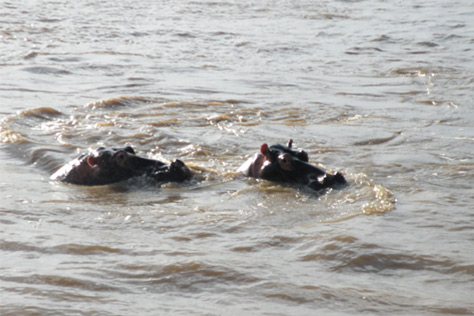We start our tour at St Lucia with a sunset cruise down the St Lucia Estuary, it is as brilliant as ever and a real mangrove swamp with all the trappings of all the hippo’s and crocodiles in the estuary, and the violin and hermit crabs in the swamps, the vegetation in the swamps is entirely different to anything you know. Then there is the bird life that frequents such an abundant water supply, naturally the ever present Fish Eagles, are to be seen around as are the pelicans and flamingos and numerous other bird species.
There are many touring opportunities flowing out of St Lucia – on a tour down the Western Shores and Charters Creek you see elephant, buffalo, rhino we did not see the leopard, and then there is the tour down the Eastern Shores and Cape Vidal, this tour takes you along the shoreline with beautiful panoramas and beaches and great snorkelling opportunities. Of course the whole Isimangaliso Wetland Park offers many opportunities for fly-fishing, there are even areas dedicated to spear fishing.
We did a day-light safari into iMfolozi Game Reserve – this is the more southerly reserve of the original hunting grounds of the Zulu Kings and the oldest game reserve in Southern Africa, there was a giraffe kill, struck down by lightning which creates all the excitement of the interaction between the hyenas and the vultures, there were many sightings of White Rhino and antelope mainly Nyala. The ravages of the on-going drought could be seen everywhere. This will be a tough winter for this region as we wait for the summer rains.
Isimangaliso coastline is home to a turtle population that return annually to lay their eggs on the shoreline during the months of October and November and the hatchlings return to the sea in February and March. St Lucia is visited by one of the largest turtles, namely the enormous Loggerhead that can weigh up to 900Kg in weight, the other turtles that can be seen are the Hawksbill and Leatherback.
The turtles come ashore mainly at night and you can only enter the area under the supervision of the rangers, the spectacle may be observed from close quarters. The rangers are responsible for gathering data relating to the sightings and all the information is fed back into marine research at the Durban University.
We did a tour of the Dukuduku Forest, one of the major suppliers of raw materials to the natural medicine market and a region that needs to be preserved, many of the plants are threatened with uncontrolled harvesting and moves are afoot to try and control this practice. The area supports a population of around 30,000 people, there are schools and an infrastructure for water and sanitation but this may in time be turned into a protected reserve, property is available across the road at Khula Village where there is a proper infrastructure for housing and property for development is available. There is a butterfly-dome here and well worth a visit.
There is another whale, the Humpback that migrates from Antarctica up our coast-line to breed in the warm waters of Mozambique, viewing can be done from an offshore boat during the months from June to December, and you can also view the whales from the tower at Cape Vidal. Occasionally in the deep ocean you get sightings of the Sperm Whale.







